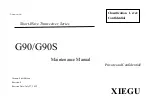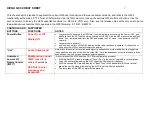
TS-5700
CIRCU IT D ES CRI PTI O N
6)
M icrophone a m p l ifier AGC processi n g
T h e digital AGC processing i s carried out for t h e sig
nal from the microphone by the DSP. The microphone
gain is managed by changing the maximum gain of the
AGC. The attack time constant is set to a high value to
prevent responding to any noise signals which are in
put momentarily. The limiter limits the upper limit of
the accumulated value in the DSP according to the
microphone gain setting.
Fig. 26
7 ) CW tu ne fu nction
W h en the conventiona l mode l s performed CW
zero-in, it receives CW receive tone and sidetone and
performs tuning by changing the receive frequency
manual ly so that there is no difference in the frequen
cies of the two tones. The TS-570D is designed to do
it automatical ly. The DSP has an auto notch filter with
the CW pitch frequency at the center. The auto notch
filter converts the error data for automatic tracking to
the beat to DDS frequency data and sends it to the
microcomputer. The microcomputer adjusts the re
ceive frequency automatical ly. The CW zero-in is car
ried by repeating t h is process. If the CW signal is
weak or if there are several stations in the receive
band, they cannot be tuned precisely.
8) CTCSS decode
The TS-570D is the first HF fixed model that has a
CTCSS decoder which operates in FM mode. The mi
crocomputer checks CTCSS decode by detecting the
subtone in the receive signal using the DSP to turn the
audio signal output on and off.
Fig. 27
TSO
'5
c.
c:
<ii
c:
Cl
U'i
9 ) Noise/i nterference processing
The noise/interference processing, SPAC, line en
hancer, and beat cancel functions of the TS-570D are
made possible by digital signal processing by the DSP.
They are outlined below.
•
SPAC ( N R2)
SPAC stands for Speech Processing System by use
of Auto Correlation function. It extracts periodical sig
nals (target receive signals) using a self-correlation
function and suppresses noise. SPAC improves the S/
N effectively, but may produce noise because signals
discontinue when periodical signals are extracted.
Corre l at i o n
Out LPF
Cyc l e cont.
Fig. 28
•
Line enha ncer
The line enhancer emphasizes the periodical signal
and suppresses noise using a 64·-tap F I R adaptive fil
ter. The convergence speed of the adaptive filter is
changed in proportion to the signal strength meter
level . If the signal strength meter level is high, the
change of the tone is suppressed. The value of the
delay adapted according to the mode is changed to
achieve the optimum effect for each mode.
y(n)
=S(n)+d(n)
•
Beat cancel
s(nl
=Line enhancer
+
L - - -
d(n)
=Beat canceller
Tracking speed
Fig. 29
The beat canceler suppresses beat interference by
adding the periodical signals with reverse phases us
ing the same 64-tap F I R adaptive filter as for the line
enhancer. The F I R filter can suppress several beats.
The convergence speed of the adaptive filter is set to
the optimum value for producing the beat cancel ef
fect . However, an audio signal may be canceled as it
is regarded as a periodical signal.
29
















































